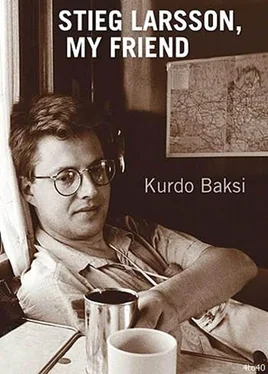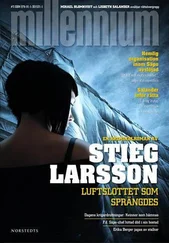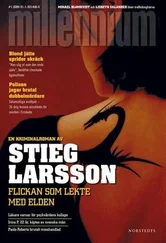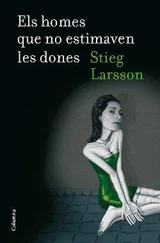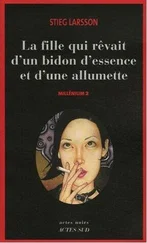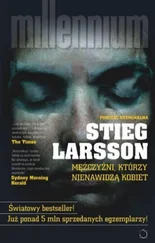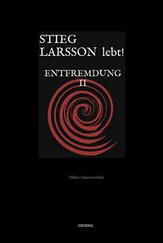Who was Stieg?
I wrote that question down on a piece of paper and stared at the words. It suddenly occurred to me that the reason he worked himself to death might be hidden away in his past. The fact is that even if we try to persuade ourselves otherwise, no human being is capable of working like Stieg did. Did he do it in an attempt to achieve ambitious goals he had set himself, or was it some kind of escapism? It may sound odd, but I really do believe that Stieg often thought he could change the world single-handedly if he only worked hard enough at it. I sometimes used to feel guilty because I myself was in favour of gradual change, while he could only feel at ease when he was working flat out. I have never met anybody with such a compulsive drive to work, such strength and energy.
*
Once I had asked myself that question – who was Stieg? – I noticed how the journalist in me was slowly but surely aroused once more. I started researching his early life and scanning the local newspapers Västerbottens Folkblad and Västerbottens Kuriren . Every day I learned something new about him – his homes in Hagmarksvägen and Ersmarksgatan in the Sandbacka district of Umeå, his years at the Hagaskolan primary school, then the Dragonskolan grammar school. I searched for his name in driving-school records, even though I knew he didn’t have a licence. Perhaps it was a decision he had made early on without realizing the implications: the first piece of advice the police give to an individual living under threat is not to own a car, because the easiest way to track someone down in Sweden is through the driver and vehicle licensing authority.
When I discovered that Stieg had worked as a dishwasher at Sävargården in Umeå, I telephoned the well-known restaurant; none of the current staff had been working there at the same time. I was astonished to learn that he had completed his two years of national service with the I20 infantry regiment in Umeå. It is almost impossible to imagine Stieg as an infantryman. More credible was a spell as a manager at the pulp mill in Hörnefors.
Slowly but surely I worked my way back in time; it was like fitting together the pieces of a jigsaw puzzle. Almost before I knew where I was, I found myself in Östra Valliden and Varuträsk, just outside Skellefteå. There I got to know about a boy whose father had died and so had found himself in a foster home. This was Stieg’s maternal grandfather. His first job was as a farmhand; then, like so many of his contemporaries in the 1920s, he worked as a navvy, building roads, or as a lumberjack. In his free time he hunted game in the forests or fished in the lakes around Bjursele.
His name was Severin Boström. It became obvious to me that in order to know Stieg Larsson, you needed to become acquainted with his maternal grandfather. People in Ursviken said of Severin that he was “a very passionate man”. He had moved to Ursviken, between Skellefteå and Skelleftehamn, in order to run an engineering workshop. He repaired chainsaws, mopeds and bicycles. As soon as he could afford it he bought a car. During the Second World War, like so many people in those northern parts, he became a devout anti-Nazi. In his case, his convictions were so strong that they were a key influence on his notion of right and wrong.
One summer’s day in 1953, at a dance in the People’s Park in Skellefteå, Severin’s daughter Vivianne met a man by the name of Erland Larsson, who was on a fortnight’s leave from his military service. They fell in love, and a year later, on 15 August, 1954, the young pair had a son: Karl Stig-Erland Larsson.
It was far from easy for a young couple to make a living in those days. For a while Stieg’s grandfather and father both worked at the Rönnskär sawmill, but before long Erland and Vivianne decided to seek their fortune in Stockholm, realizing that they would be forced to leave their one-year-old son with his maternal grandparents near Nordsjö.
It was 1962 before the family could be reunited. By then, Stieg had acquired a younger brother, Joakim, born in 1957. They all moved into a new home in Umeå, where Vivianne worked in a clothes shop and Erland was employed as an interior decorator for the clothes chain Berlins, which had shops in central Umeå, Skellefteå, Piteå and Örnsköldsvik.
While I was tracing Stieg’s past, I frequently felt a kind of kinship with him. I was also forced to move house frequently because of my father’s political activities. I like to think that children who grow up in such conditions develop a blend of rootlessness and restlessness. Combine those qualities with curiosity and you have a mixture that can be extremely important for a journalist later in life; but when you are a child, you often feel very much alone in the world.
As a teenager I ended up in Tensta, in Greater Stockholm, in a new country and without any friends. Stieg had also moved there only a few years previously – for him it was the same country, of course, but coming from Västerbotten in the remote north no doubt caused him his fair share of culture shock.
When we first met, as adults, Stieg and I had one thing very much in common: we had very few close friends.
With hindsight I have often thought that the restlessness we shared was an important reason why we got on so well together. When you have few friends around you, you often develop interests that fit well with your situation. In Stieg’s case, films and the night sky were of great importance. Erland had a job for a while as the caretaker of a cinema, so Stieg and his younger brother were often able to sneak in and watch films. Stieg loved to immerse himself in this make-believe world, entranced by the captivating happenings on the silver screen. The same thing applied to his star-gazing, the heavens a grand mystery of which an individual could never experience more than a tiny fraction.
When Stieg celebrated his twelfth birthday he was given a Facit typewriter and a telescope. These were by no means cheap presents, probably costing a lot more than his parents could afford. For Stieg, it was the fulfilment of a dream. One of his diaries contains several entries like this one: “1/2.1968, P.S. We spent a quarter of an hour searching for Uranus, without success.”
It was around this time that Stieg became interested in politics, despite still being so young. His mother had become increasingly involved in trade union work and was soon a member of the local housing committee, active on the Disability Council and one of the founders of the first local authority equality committee. It was at this time that Stieg met Eva Gabrielsson, who was to become his partner. The occasion was a 1972 rally of the National Liberation Front protesting against the Vietnam War.
A friend of his told me that Stieg was also a keen photographer as a teenager – but the pictures were not the usual family snaps: he took photographs “in order to record injustice in the world”.
Umeå soon became too small for Stieg. He had big ambitions. At the age of seventeen he hitched a lift on a long-distance lorry to Stockholm, and from there set off for Algeria. He had raised the necessary money by taking temporary jobs as a newspaper delivery boy and a dishwasher. But he didn’t get very far: he was mugged, lost all his travel money and had to return to Umeå. Nevertheless, being the stubborn mule that he was, he worked hard to raise the funds for another attempt. This was the beginning of a series of long journeys. He finally reached Algeria and sold his leather jacket in order to be able to prolong his stay. After a two-year gap to do his military service in Sweden, he set off on his travels once more – this time to Africa.
He was twenty-one when he landed in Khartoum, continuing from there to Eritrea and Ethiopia. The innocent abroad who had lost all his money almost before he had even set off was by now a seasoned globetrotter. In northern Ethiopia Stieg was interrogated by M.I.6, the British security service. In addition to being scared stiff and angry, he fell seriously ill after staying in a cheap hotel in Addis Ababa. For some considerable time he had no opportunity to contact anyone in Sweden, and it was not until he arrived in Kenya in a bus convoy that he could send a message confirming that he was O.K. From Kenya he continued on to Uganda, where he was able to catch a flight to Moscow, and from there back home to Sweden.
Читать дальше
